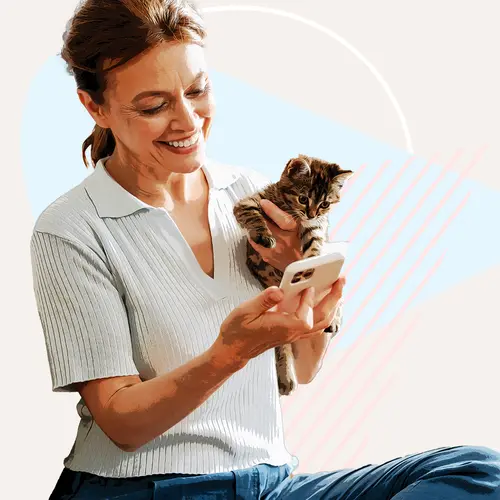The purring cat. It may well be considered the epitome of contentment. But there’s much more to purring than meets the ear.
Research is starting to shed some light on purring -- starting with how cats do it.
How do cats purr? Experts have offered a number of theories over the years. Most now say that purring begins in the brain.
A rhythmic, repetitive neural oscillator sends messages to the laryngeal muscles, causing them to twitch at the rate of 25 to 150 vibrations per second (Hz). This causes a sudden separation of the vocal cords, during both inhalation and exhalation - the unique feline vibrato.
“Opera singing for cats,” is what animal behaviorist Karen L. Overall, VMD, PhD calls it. But the purr is usually so low-pitched that we tend to feel it as much as hear it.
Housecats Aren’t the Only Ones Who Purr
Purring isn’t the sole domain of domestic cats. Some wild cats and their near relatives - civets, genets, mongooses - also purr. Even hyenas, guinea pigs, and raccoons can purr.
Cats that purr, such as mountain lions and bobcats, can’t roar, however. And cats that roar, such as lions and tigers, can’t purr. The structures surrounding their voice box (larynx) aren’t stiff enough to produce a purr.
But it appears these cats evolved the roar for good reason -- mainly to protect their prides, says Benjamin L. Hart, DVM, PhD, distinguished professor emeritus at the University of California, Davis, School of Veterinary Medicine.
“If you’re a big cat and you have to move around a lot to get prey, loud roaring plays a huge part in maintaining your territory,” Hart says.
But small cats are loners and don’t compete with each other for meals, Hart says. Their communication doesn’t need to be far-reaching. For them, scent marking does the territorial trick (as some unfortunate cat owners quickly learn).
The Purpose of Purring
If roaring serves an evolutionary purpose, why do cats purr? We humans have long perceived purring as a simple sign of pleasure, in particular, contentment with our company.
Although contentment does appear to produce purring, cats also purr when frightened or threatened. One way to think about this is to equate purring with smiling, says Kelly Morgan, DVM, clinical instructor at the Chicago Center for Veterinary medicine of the University of Illinois at Urbana-Champaign College of Veterinary Medicine in Chicago.
“People will smile when they’re nervous, when they want something, and when they’re happy, so perhaps the purr can also be an appeasing gesture,” Morgan says, adding that this is purely speculation.
Purr-suasive Purrs
If you’ve ever wondered why your cat is so hard to ignore each morning, you’ll take a special interest in a recent study conducted by researchers at the University of Sussex in Brighton, U.K.
Karen McComb, PhD, who headed the study, decided to explore the unique characteristics of these insistent purrs after wondering why her own cat could be so annoying. In the study, recordings of 10 cats’ purrs revealed that cats sometimes develop a “twist on purring.”
Cats add a vocalization into the mix to solicit responses from humans, Hart says. “Added to the basic 25 Hz purr is an overlay of a high-frequency cry-meow that humans perceive as somewhat obnoxious,” he says. “Cats apparently learn to do this to get people to feed them sooner.”
This solicitation purr seems to develop more often in quiet households where cats have a one-on-one relationship with a human, and the purr is less likely to be overlooked. But even people with no cat experience perceived this special purr as more urgent and less pleasant. McComb's team suggests that cats may have learned how to tap into a mammalian response for nurturing offspring by embedding a cry within a call that’s normally associated with contentment.
“I wonder if what we’ve done is to select pet cats to give us signals that they need us,” says Overall, author of Clinical Behavioral Medicine for Small Animals.
Healing Powers of the Purr?
Cats appear to purr for a host of other reasons as well. They purr when in pain or in labor, when ill or injured, or even when near death. Kittens also purr soon after birth. What could account for all this energy expenditure - especially during times of vulnerability? Could it be there’s a significant survival advantage?
Researcher Elizabeth von Muggenthaler of the Fauna Communications Research Institute in North Carolina (FCRI) is a specialist in the field of bioacoustics. This is the study of the frequency, pitch, loudness, and duration of animal sounds related to their behavior. She was one of the first to pull several strands of research together, and propose that felines do gain evolutionary healing advantages from the purr.
Many experts theorize that the 25 Hz frequency of the cat’s purr might offer a kind of built-in physical therapy. It’s probably no accident that this frequency is also used in humans to help wounds heal faster, Hart says.
Good Vibrations - For Humans, Too
Cats have overtaken dogs as the number one pet in the U.S., where 60% of homes have at least one pet, says Rebecca Johnson, PhD, RN, FAAN, director of the Research Center for Human Animal Interaction. Maybe one reason is because cats do a better job of lowering stress and blood pressure than many other pets, and purring may help with that.
“Purring is an auditory stimulus that people attribute to peacefulness and calmness," Johnson says. Whether right or wrong, we generally construe it as something positive. “That gives us positive reinforcement for what we’re doing and can contribute to the whole relaxation effect when we interact with our cats.”
And that’s a pretty sweet deal for a simple stroke of a feline’s fur.

